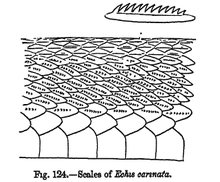Common sand rattle otter
| Common sand rattle otter | ||||||||||||
|---|---|---|---|---|---|---|---|---|---|---|---|---|

Common sand-rattle otter ( E. carinatus ) |
||||||||||||
| Systematics | ||||||||||||
|
||||||||||||
| Scientific name | ||||||||||||
| Echis carinatus | ||||||||||||
| ( Schneider , 1801) |
The common sand rattle otter ( Echis carinatus ) is a species of the vipers (Viperidae) that is distributed over large areas of Asia. Due to its way of life and choice of habitat near human dwellings as well as its very strong poison, it is one of the most dangerous poisonous snakes for humans.
features
The common sand rattle otter reaches an average length of about 60 to 70 cm with a maximum length of about 80 cm. It is one of the medium-sized types of vipers. The physique is slightly stocky, but compared to puff adders or other vipers, it is relatively slim. The body color of the sand rattle otters is very variable: The spectrum of the basic color ranges from a sand brown to gray brown to dark brown. The back is mostly darker in color than the sides of the animals and has a drawing of light crossbars, which are surrounded by dark scales. These bars extend from the neck to the tail. The sides of the body can have light wavy lines or V-shaped drawings. The head also has a light pattern on the top, which can resemble an X, a V or a skewer. The ventral side is light cream white and has dark speckles.
The head is clearly separated from the body and has the shape of a rounded triangle. The eyes, which are relatively far in front of the head, are very large and have vertical, slit-shaped pupils . The top of the head is covered with many irregular and keeled scales. Below the eyes are two rows of under eye shields ( supraocularia ), below are 10 to 12 upper lip shields ( supralabials )
The scales of the body are also strongly keeled and can generate a typical, rattling noise by rubbing against each other, which gave the sand rattle otters their name. There are between 25 and 37 rows of scales around the middle of the body. Unlike all other vipers, all members of the genus Echis have undivided under- tail shields ( Subcaudalia ).
distribution and habitat
The common sand rattle otter is distributed in several subspecies over large parts of Asia. The total area ranges from India , Bangladesh , Sri Lanka , Pakistan , Afghanistan , Turkmenistan , Uzbekistan , Tajikistan to Iran . There are also populations in Iraq and the Arabian Peninsula .
The Egyptian sand otter ( Echis pyramidum ) can be found in Africa , which was previously considered a subspecies of the common sand otter, but is now recognized as an independent species.
As a habitat, the animals prefer dry areas with boulders and sparse vegetation. They live mainly on mountain slopes in desert and steppe areas, in wadis and in the outskirts of agricultural areas, overgrown gardens and oases .
Way of life
The common sand rattle otter is predominantly nocturnal and feeds primarily on small mammals such as mice and rats as well as other small animals such as birds, lizards, frogs and other snakes. Their locomotion is meandering or crosswinding. By rubbing the flank scales together, the snake generates a typical rattling noise as a warning sound when it feels disturbed. When threatened, it also rolls up like a plate and strikes very quickly by letting its head snap forward.
The snake is egg-bearing ( ovoviviparous ) and gives birth to up to 15 young snakes per litter.
Snake venom
The venom of the common sand-rattle otter is very haemotoxic , medical treatment with an adequate antivenin is necessary. The strong irritability as well as the proximity to human agricultural areas lead to frequent bites, which makes it one of the most dangerous snake species in its range. In India, for example, alongside the chain viper , the spectacled snake and the common krait, it is one of the four species to which the majority of deadly snake bites can be traced back ( Big Four ).
Echistatin , a disintegrin and part of the poison secretion of the common sand rattle otter , served as the starting substance for the development of tirofiban (a drug from the group of platelet aggregation inhibitors ).
Systematics
Various subspecies are listed in the literature :
- E. c. carinatus
- E. c. astolae
- E. c. multisquamatus
- E. c. sinhaleyus
- E. c. sochureki
The number and status of the subspecies are partly unclear and have been discussed repeatedly. The Reptile Database names two subspecies: E. c. carinatus ( nominate form ) and E. c. sochureki (as of July 2018).
Individual evidence
- ↑ a b Echis carinatus in The Reptile Database ; accessed on July 15, 2018.
- ↑ Kastin: Handbook of Biologically Active Peptides , Elsevier, 2011. ISBN 978-0-12-369442-3 .
literature
- David Mallow, David Ludwig, Göran Nilson: True Vipers. Natural History and Toxicology of Old World Vipers , Krieger Publishing Company, Malabar (Florida) 2003; Pp. 180-182. ISBN 0-89464-877-2 .
- Ulrich Gruber: The snakes of Europe. Franckh'sche Verlagsbuchhandlung, Stuttgart 1989; Pages 162-164. ISBN 3-440-05753-4 .
